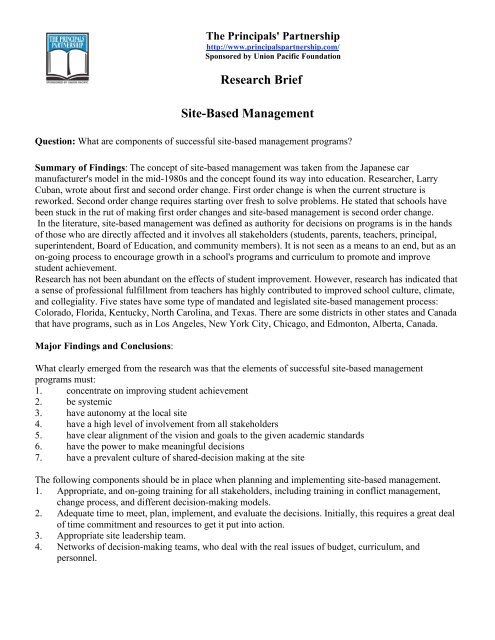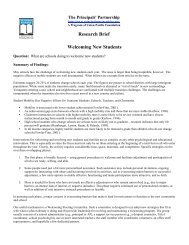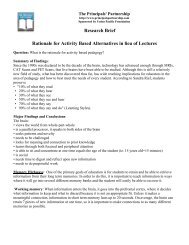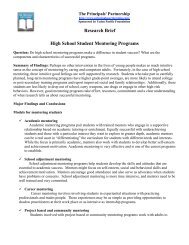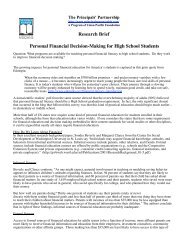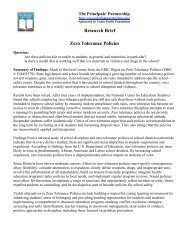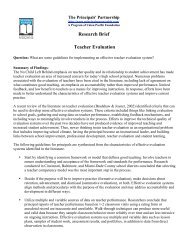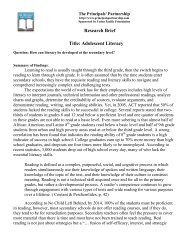Research Brief Site-Based Management - Online Effectiveness ...
Research Brief Site-Based Management - Online Effectiveness ...
Research Brief Site-Based Management - Online Effectiveness ...
Create successful ePaper yourself
Turn your PDF publications into a flip-book with our unique Google optimized e-Paper software.
The Principals' Partnership<br />
http://www.principalspartnership.com/<br />
Sponsored by Union Pacific Foundation<br />
<strong>Research</strong> <strong>Brief</strong><br />
<strong>Site</strong>-<strong>Based</strong> <strong>Management</strong><br />
Question: What are components of successful site-based management programs<br />
Summary of Findings: The concept of site-based management was taken from the Japanese car<br />
manufacturer's model in the mid-1980s and the concept found its way into education. <strong>Research</strong>er, Larry<br />
Cuban, wrote about first and second order change. First order change is when the current structure is<br />
reworked. Second order change requires starting over fresh to solve problems. He stated that schools have<br />
been stuck in the rut of making first order changes and site-based management is second order change.<br />
In the literature, site-based management was defined as authority for decisions on programs is in the hands<br />
of those who are directly affected and it involves all stakeholders (students, parents, teachers, principal,<br />
superintendent, Board of Education, and community members). It is not seen as a means to an end, but as an<br />
on-going process to encourage growth in a school's programs and curriculum to promote and improve<br />
student achievement.<br />
<strong>Research</strong> has not been abundant on the effects of student improvement. However, research has indicated that<br />
a sense of professional fulfillment from teachers has highly contributed to improved school culture, climate,<br />
and collegiality. Five states have some type of mandated and legislated site-based management process:<br />
Colorado, Florida, Kentucky, North Carolina, and Texas. There are some districts in other states and Canada<br />
that have programs, such as in Los Angeles, New York City, Chicago, and Edmonton, Alberta, Canada.<br />
Major Findings and Conclusions:<br />
What clearly emerged from the research was that the elements of successful site-based management<br />
programs must:<br />
1. concentrate on improving student achievement<br />
2. be systemic<br />
3. have autonomy at the local site<br />
4. have a high level of involvement from all stakeholders<br />
5. have clear alignment of the vision and goals to the given academic standards<br />
6. have the power to make meaningful decisions<br />
7. have a prevalent culture of shared-decision making at the site<br />
The following components should be in place when planning and implementing site-based management.<br />
1. Appropriate, and on-going training for all stakeholders, including training in conflict management,<br />
change process, and different decision-making models.<br />
2. Adequate time to meet, plan, implement, and evaluate the decisions. Initially, this requires a great deal<br />
of time commitment and resources to get it put into action.<br />
3. Appropriate site leadership team.<br />
4. Networks of decision-making teams, who deal with the real issues of budget, curriculum, and<br />
personnel.
The Principals' Partnership<br />
http://www.principalspartnership.com/<br />
Sponsored by Union Pacific Foundation<br />
<strong>Research</strong> <strong>Brief</strong><br />
5. Communication is thorough and done with all stakeholders through several channels, i.e. Web,<br />
newsletters, and school pre-recorded phone messages.<br />
6. Concurrently, the principal leads and shares power.<br />
7. All who make the decisions are accountable and responsible.<br />
8. Build in some type of monetary and non-monetary rewards for moving forward and meeting goals.<br />
9. Develop and maintain resources from the parents and community.<br />
10. Have technical assistance available when needed.<br />
Some pitfalls of which to be aware:<br />
1. The limits of decision-making and power are unclear and undefined.<br />
2. The principal directs and tells, rather than guides.<br />
3. When only the superintendent and principal are held accountable for decisions.<br />
4. When decision-making groups do not have the power to make the real decisions and may get mired in<br />
unimportant details.<br />
<strong>Online</strong> Resources:<br />
• School-<strong>Based</strong> <strong>Management</strong>: Rhetoric vs. Reality<br />
An overview of the research especially, especially from Kentucky and Chicago are given in this article.<br />
It also provides a list of the eight critical factors that are included in successful site-based management<br />
programs.<br />
http://www.ecs.org/clearinghouse/26/58/2658.htm<br />
• <strong>Site</strong>-based decision-making: Its potential for enhancing learner outcomes<br />
Items to consider when determining whether or not to utilize site-based management as well as how the<br />
roles of participants need to change are included in this piece. Although it is an older article, the<br />
information is still valid.<br />
http://www.sedl.org/change/issues/issues14.html<br />
• <strong>Site</strong>-<strong>Based</strong> <strong>Management</strong>: Boon or Boondoggle<br />
An overview of the components that need to be in place in order for site-based management to be<br />
successful are highlighted. It also lists problems that can occur if the implementation is not done<br />
thoroughly.<br />
http://www.education-world.com/a_admin/admin176.shtml<br />
• Thinking Differently: Recommendations for 21 st Century School Board/Superintendent Leadership,<br />
Governance, and Teamwork for High Student Achievement<br />
This article describes ways in which the superintendent and Board of Education can work in concert in<br />
order to help students achieve at higher levels.<br />
http://www.nesdec.org/Thinking_Differently.htm
The Principals' Partnership<br />
http://www.principalspartnership.com/<br />
Sponsored by Union Pacific Foundation<br />
<strong>Research</strong> <strong>Brief</strong><br />
Submitted By: Dr. Karen Walker, University of Maine, Farmington<br />
http://www.principalspartnership.com/<br />
This is provided as a service to educators by The Principals Partnership and Union Pacific Foundation, neither of which assumes any responsibility for the content<br />
of the brief or the positions taken by the authors or the Web sites or other authors whose works are included. This research brief reflects information currently<br />
available and is not the official position of The Principals Partnership or Union Pacific Foundation.<br />
Disclaimer: All URLs listed in this site have been tested for accuracy, and contents of Web sites examined for quality, at the time of addition. Content accuracy and<br />
appropriateness, however, cannot be guaranteed over time as Web sites and their contents change constantly. The author takes no responsibility for difficulties<br />
which may result from the use of any Web site listed herein. Please notify the Webmaster if you find any dead links or inappropriate material.<br />
Permission: You may use or download content for research or educational purposes, or for your personal, noncommercial purposes, provided you keep unchanged<br />
all copyright and other notices with them. No other use of any content is permitted. You agree that you will make only lawful use of this research brief, and will<br />
only use these briefs in compliance with all federal, state and local laws and regulations. You agree that you will make no use of the research that violates anyone<br />
else's rights, including copyright, trademark, trade secret, right of privacy, right of publicity or other rights.


